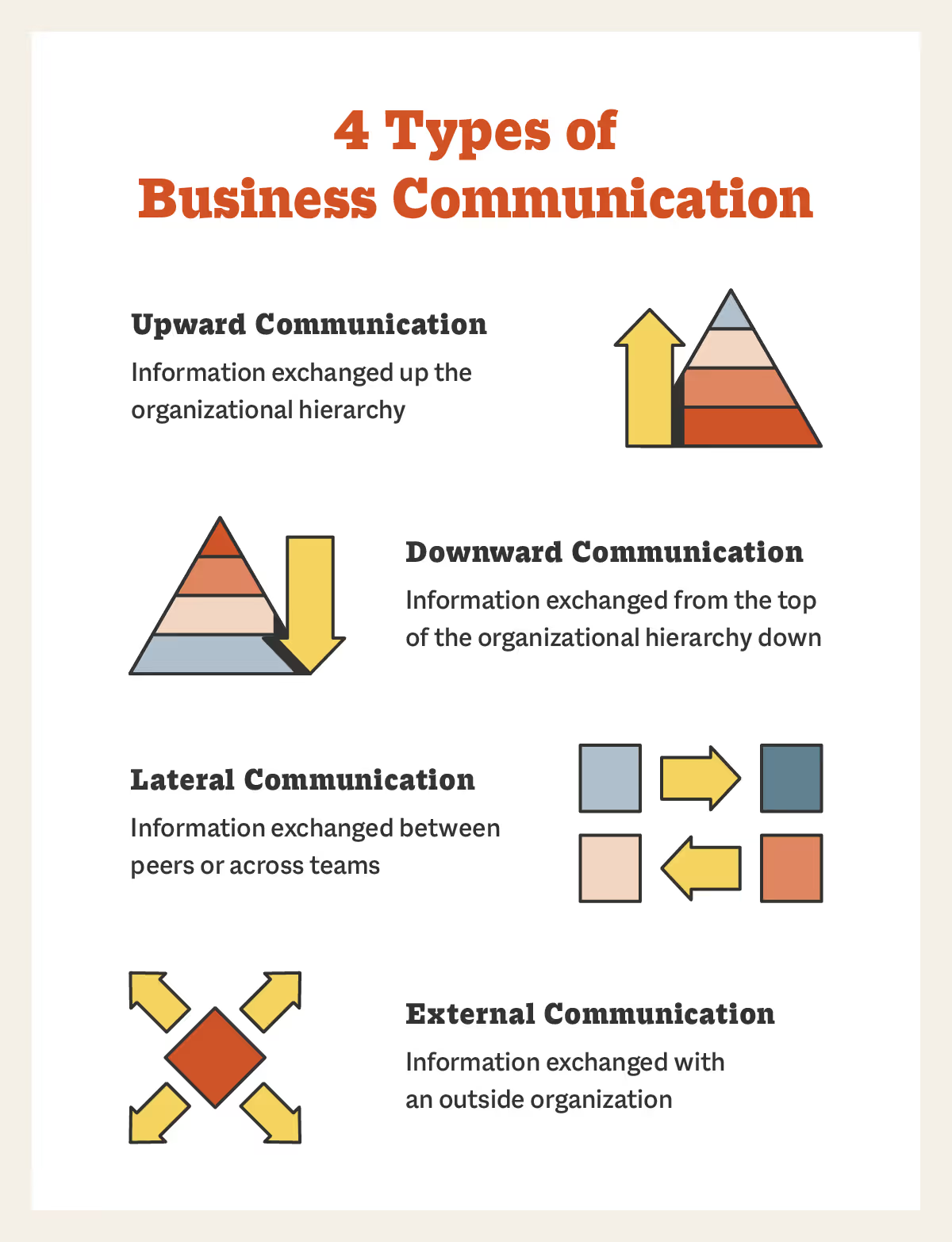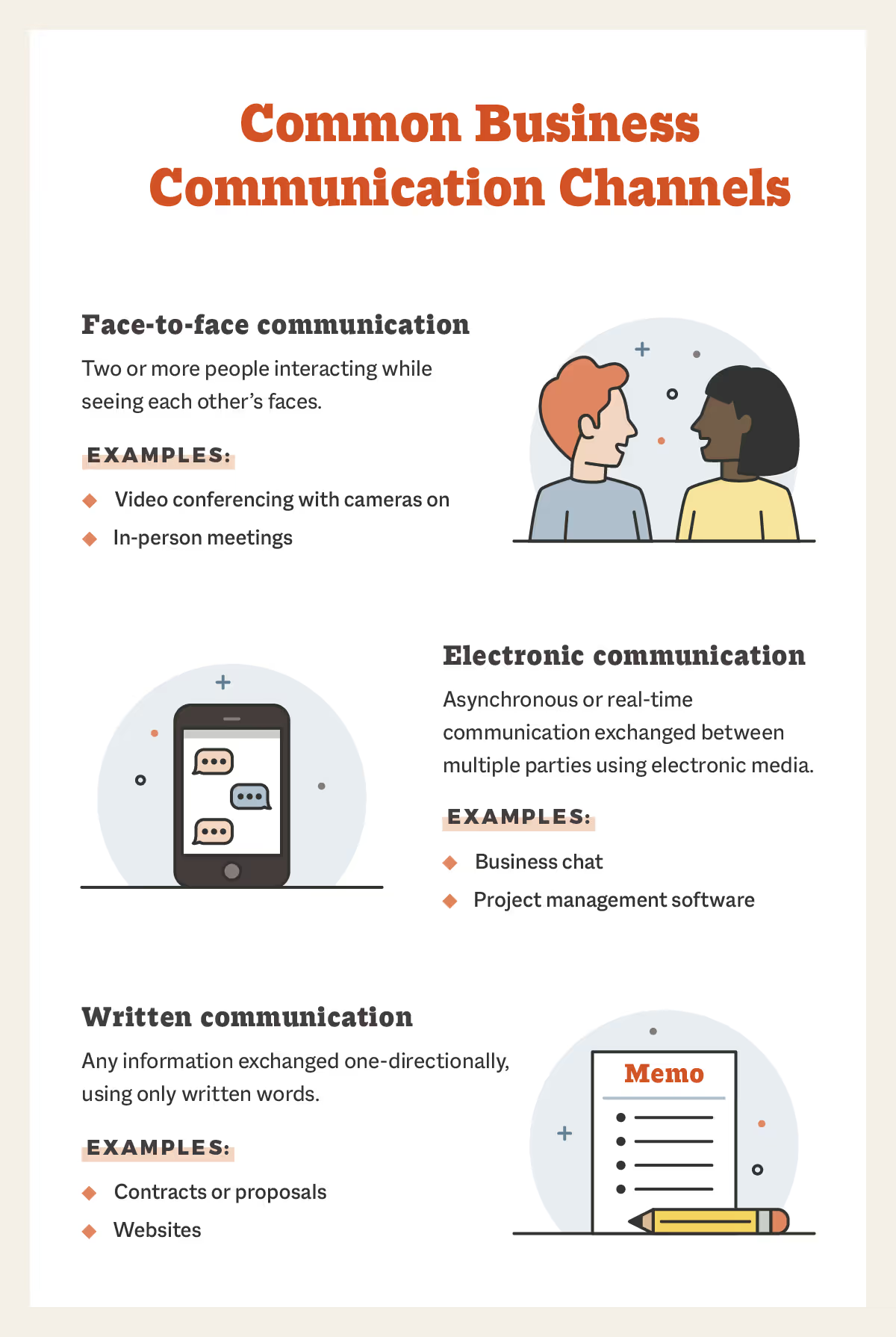4 Types of Business Communication and How They Benefit Your Business
4 Types of Business Communication and How They Benefit Your Business

Everyone has heard the phrase “communication is key,” and it especially rings true in business. Whether you’re a manager relaying internal goals to your team or a virtual receptionist fielding customers, clear and productive business communication can make or break a company’s success.
Effective communication is essential in business, but the trick is ensuring that your team communicates successfully all the time. We understand that this isn’t an easy feat to achieve — but we were named the Best Business Client/Customer Communication Services Specialists in the U.S., so we’ve broken down the different types of business communication to help your company interact more effectively.
We’ll teach you about the four types of business communication and their strengths and weaknesses, so that your team can better adapt their communication to every situation.

The 4 types of business communication
Business communication involves the exchange of information within members of an organization and from the organization to outside parties. The four main types include upward communication, downward communication, lateral communication, and external communication.
The upward, downward, and lateral communication types refer to internal business communication or information exchanged within an organization. This is distinct from external business communication, which refers to interactions that happen between the organization and an outside party.
We’ve outlined the strengths and weaknesses for each business communication type and tips for successful communication in each scenario.
1. Upward communication
Like the name suggests, upward communication deals with any interaction that travels up the hierarchy of your business. The most common example is when a direct report communicates to a supervisor or manager. Another instance is when a manager reaches out to directors or high-level executives.
This type of business communication allows upper management to stay informed about what is happening with the company. It also provides employees with the opportunity to ask questions, raise concerns, or make suggestions.
Examples of upward communication:
- Direct report to manager
- Manager to high-level executive
Strengths of upward communication:
- Allows for the exchange of information from direct reports to upper management
- Helps management respond to employee needs and identify problems before they escalate
- Promotes interaction across different levels in a company
- Cultivates an open and friendly company culture
Weaknesses of upward communication:
- Communication is hindered by existing power dynamics because employees may feel uncomfortable sharing information or being fully open and honest with superiors
- Employees are often limited by their level of access to management, and they need a clear channel of communication to successfully communicate up the organizational hierarchy
Tips for success:
- Management should promote and model open communication by asking for feedback and checking in with employees regularly
- Management should practice active listening, especially when face to face, and empathy when direct reports communicate feedback
- Leverage multiple communication channels by providing internal feedback surveys or forms, drop-in office hours, Q&A sessions, and email or chat threads
- Foster a company culture based on openness, inclusivity, honesty, and growth
2. Downward communication
Downward communication refers to the exchange of information from the top of an organization down to lower levels of the organizational hierarchy. Although the direction is the opposite of upward communication, these two types often work hand in hand.
Examples of downward communication include when a manager relays instructions to a direct report in an email or an executive communicates business goals to a manager. This type of communication allows management to distribute information, delegate responsibilities, and enforce standards.
Examples of downward communication:
- Executive to manager
- Manager to direct report
Strengths of downward communication:
- Shares and disseminates information among the wider team
- Helps management delegate responsibilities and company priorities
- Communicates about the big picture (e.g., business goals, mission, etc.)
- Enforces regulations that must be followed
- Addresses disciplinary action or promotions
Weaknesses of downward communication:
- Organizational hierarchy may stifle efficient communication because communicating messages from the top down is slow
- Messages may get distorted traveling down the organizational hierarchy
- Downward communication without upward communication may leave employees feeling frustrated or undervalued
Tips for success:
- Use scheduled written communication like bulletins, memos, or announcements to distribute information quickly and clearly
- Management should provide an open channel of communication for questions, clarification, or feedback
- Management should find a balance between downward and upward communication
- Management should remain personable yet professional when communicating
3. Lateral communication
When employees communicate across departments or with peers of equal rank in the organization, this is considered lateral or horizontal communication. Lateral communication examples include a coworker calling another coworker or a team of managers deliberating a potential new hire.
The purpose of lateral communication is to foster collaboration and coordination in an organization. Without productive lateral communication, an organization may fail to reach their business goals.
Examples of lateral communication:
- Coworker to coworker
- Manager to manager
Strengths of lateral communication:
- Allows for knowledge sharing and problem solving
- Promotes team and interdepartmental cohesion and coordination
- Occurs quickly and without the need for top-level approval
- Supports employee productivity and morale
- Helps avoid conflict within and across teams
- Prevents team silos and increases collaboration
- Lacks formality and lets workers speak openly
Weaknesses of lateral communication:
- There’s potential to foster an “us vs. them” mindset among separate teams
- Competition may hinder team cohesion and collaboration
- Lack of lateral communication may result in barriers that decrease productivity
- Less formality in communication can result in misunderstandings
Tips for success:
- Management should emphasize the goals of the team or larger organization to deter competition
- Promote communication dedicated to non-work related conversations to boost team cohesion and morale (e.g., virtual happy hours or coffee breaks)
- Implement project management software or tools to promote collaboration and reduce bottlenecks
- Leverage face-to-face or electronic communication like video conferencing or phone calls to clear up misunderstandings and solve problems
4. External communication
External communication deals with the exchange of information from within the organization to parties outside of the organization. For example, a team within your company may send over a proposal for an outreach campaign to a client or your organization may issue a press release to promote a new product or service.
This also includes any electronic communication that occurs through a website, email, or social media from your organization to consumers, clients, or other parties. Your organization’s external communication should be a top priority because it manages your business’s reputation and outside relationships.
Examples of external communication:
- Organization A to Organization B
- Website to consumer
Strengths of external communication:
- Builds a positive reputation for your organization
- Fosters beneficial customer/client relationships
- Helps promote company growth and success
Weaknesses of external communication:
- There’s potential to harm your company’s reputation using poor external communication
- When communicating externally, there’s less room for mistakes
- If internal communication needs work, external communication may be a challenge
Tips for success:
- Adapt communication etiquette (e.g., tone, level of formality, language) to what best fits your audience and the method of communication
- Ensure that messages to outside organizations are clear and purposeful
- Aim to build personal connections with clients or customers
- Seek to provide support and value in interactions
- Outsource external communication services to trusted professionals like Smith.ai’s virtual receptionists or 24/7 AI chatbot

Business communication channels to know
Now that you know the various types of business communication, it’s helpful to recognize the common communication channels that businesses use. In a workplace setting, there are three main methods of communication: face-to-face, electronic, and written communication.
Face-to-face communication
This method of synchronous communication occurs when two or more people interact while being able to see each other’s faces. Traditionally, this referred to a face-to-face interaction where both parties shared a physical space (e.g., an in-person meeting). However, with the rise of the virtual workplace, this can also refer to an online face-to-face interaction (e.g., a video conference).
Electronic communication
Any form of communication exchanged using electronic media (e.g., a phone or computer) is categorized as electronic communication. Electronic communication can happen in real time or asynchronously.
Common examples of electronic business communication include email, live website chat, Facebook chat or other social media messaging, and communication on project management platforms.
Written communication
Information that’s exchanged one-directionally, using solely written words is classified as written communication. This channel is used a lot in business and comes in the form of reports, memos, contracts, proposals, manuals, standard operating procedures (SOPs), and press releases.
Emails, websites, and blog posts also count as electronic forms of written communication based on their one directional nature.
Note:
Some overlap exists between these channels, and it’s important to recognize that certain communication methods don’t fall neatly into one category. For example, email is a form of both electronic and written communication. You can use these categories as guides to help inform your communication in the workplace.
Additionally, communication may vary across channels based on different factors like formality, whether it’s verbal or nonverbal, or if it’s synchronous or asynchronous. These factors may impact business interactions, so it’s important to remain cognizant of them and adapt as necessary.

How business communication impacts your company’s success
Engaging in effective business communication helps your organization’s success and growth. We outline some of the major benefits of practicing good business communication both inside and outside of your organization.
Builds a positive company culture
Having open and approachable internal communication helps foster a positive culture within your company. Downward communication from leadership impacts how engaged employees are and helps to keep morale up, while open upward communication helps employees feel heard.
Additionally, collaborative lateral communication reduces competitiveness across departments and promotes cohesion within teams. It’s also useful when it comes to problem solving and reducing conflict.
Encourages innovation
It’s said that innovation only occurs through communication, and companies can move toward innovation by encouraging team interactions. Lateral communication, in the form of brainstorms and meetings, prompts teammates to exchange ideas and get their creative juices flowing.
Open upward communication also helps employees share ideas with higher-ups and take risks to innovate within the company, while downward communication conveys what leadership’s goals for innovation are. Both lateral and upward communication promote knowledge sharing as well, and external communication is used to share innovative ideas with the public.
Improves your business operations
Another benefit of using good business communication is that it can improve your business operations. Effective downward communication is essential for communicating company goals to employees and helps your organization better achieve success.
Business communication also helps with employee performance and productivity. A report found that 60% of business professionals face a communication crisis every month. Upward communication helps employees when they need guidance and lateral communication promotes synergy and collaboration so teams can solve problems and accomplish more together.
Finally, external communication helps to foster good working relationships with other organizations so that your company’s workflow isn’t hindered by others.
Keeps employees happy
Internal communication is also a tool for keeping employees satisfied, fulfilled at work, and less likely to leave their jobs. A study found that employees’ satisfaction with internal communication predicted better employee engagement and increased employer attractiveness.
Keeping open channels of communication between employees and management is necessary to cultivate good working relationships and helps managers keep a pulse on how workers are feeling.
Specifically, accessible upward communication allows employees to provide feedback on pain points in their workflow or the employee experience. Based on any feedback, management can improve processes and increase employee retention.
Promotes customer satisfaction
External communication is important for creating an engaging and valuable customer experience. When businesses are responsive, they earn more clients and win over customers.
Providing helpful and informative customer service through chat services like Smith.ai’s Live Chat is essential for increasing customer satisfaction. It also helps with problem solving and customer retention because your external communication can help to smooth over issues customers may have.
Closing:
Every type of business communication is vital to the success and growth of your company. Take the time to understand the nuances of upward, downward, lateral, and external communication so that your organization can better adapt to any situation.
Use our tips for success to help your team navigate any interaction, whether it’s internal or external, and don’t forget to leverage important resources like Smith.ai when it comes to business communication.
Source: Get Up and Learn
Take the faster path to growth. Get Smith.ai today.
Key Areas to Explore
Technical Implementation Terms
Voice user interface (VUl) design
Speech recognition integration
Text-to-speech optimization
API connectivity and webhooks
Real-time data synchronization

Your submission has been received!














.svg)



